Botanical Beach Day Trip near Port Renfrew
Botanical Beach on Vancouver Island’s wild west coast is an incredible destination if you like exploring tide pools. It also provides a taste of quintessential west coast scenery and yet it’s only 5 kilometres from the dock in Port Renfrew.
In winter Botanical Beach is a superb place for storm watching – but be very careful whenever you visit and keep an eye out for rogue waves. Access is excellent with the trailhead only about a 5 – 10 minute drive from Port Renfrew. The beach is a two hour drive from Victoria so it can be done as a day trip.
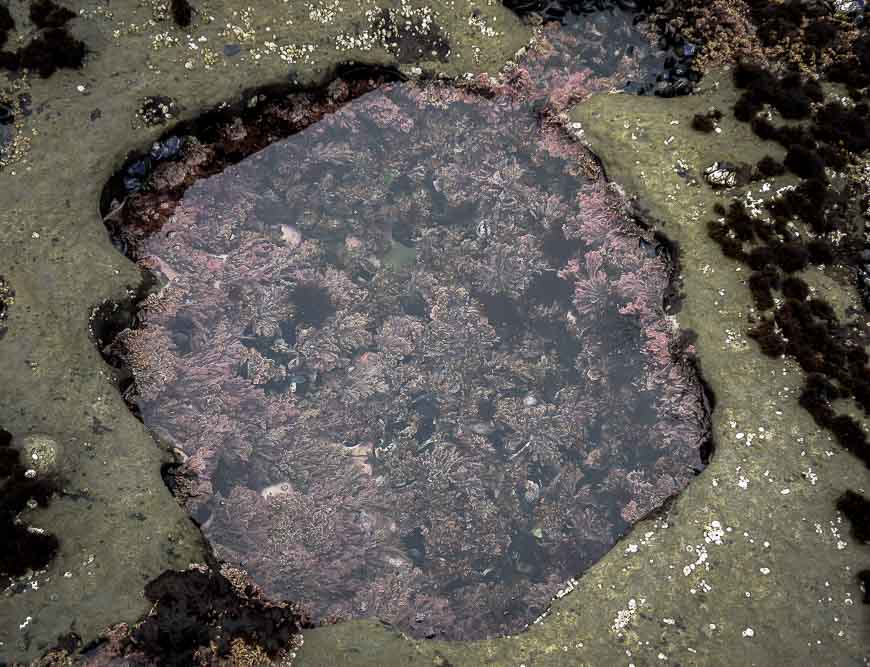
Would you like to save this?
This post includes some affiliate links. If you make a qualifying purchase through one of these links, I will receive a small percentage of the sale at no extra cost to you. Thank you very much for your support.
Botanical Beach summary
Who would enjoy a visit? The beach is a great destination for all ages though you will need to keep small children close by when you’re the beach itself.
Distance: The hike from the parking lot to Botany Bay is 0.7 km one way.
Dogs: Allowed on Botanical Beach, but they must be leashed.
Animals and plants: Hundreds of species of plants and animals live at Botanical Beach.
Tides: Be hyperaware of the tide – and try to plan your visit around a falling tide.
Rocks: The rocks at Botanical Beach are very slippery, so be sure to wear the proper footwear. A pair of thongs doesn’t cut it here. Always be on the lookout for rogue waves.
Bears: Occasionally Botanical Beach is closed because of bear activity.
Best time to visit: Botanical Beach is open year round, save for the odd closure due to bears. It’s a great area for storm watching in the winter months.
Water: There is no potable water at the beach, so if you’re planning a full day be sure to pack some along with the hiking essentials.
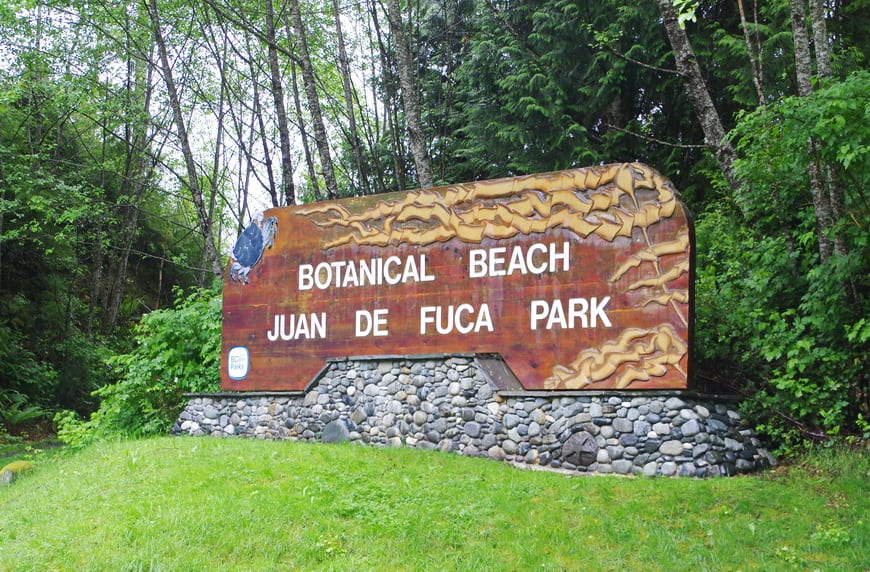
Location map of Botanical Beach on Vancouver Island
Directions and access points to Botanical Beach
From Victoria take Highway 1 to reach Highway 14. Drive the winding, narrow Highway 14 all the way to Port Renfrew. Allow 2 hours to do it. When you get to Port Renfrew, drive through town and look for the signs pointing the way to Botanical Beach.
But before you make the turnoff, I highly recommend picking up picnic supplies at the Coastal Kitchen Café. Note that it’s closed in winter. There’s a big parking lot at the end of the road when you reach Botanical Beach.
From the parking lot allow 45 minutes to walk the trail to Botanical Beach. Botanical Beach is at the north end of the well-known Juan de Fuca hiking trail. You start or end the four day hike here.
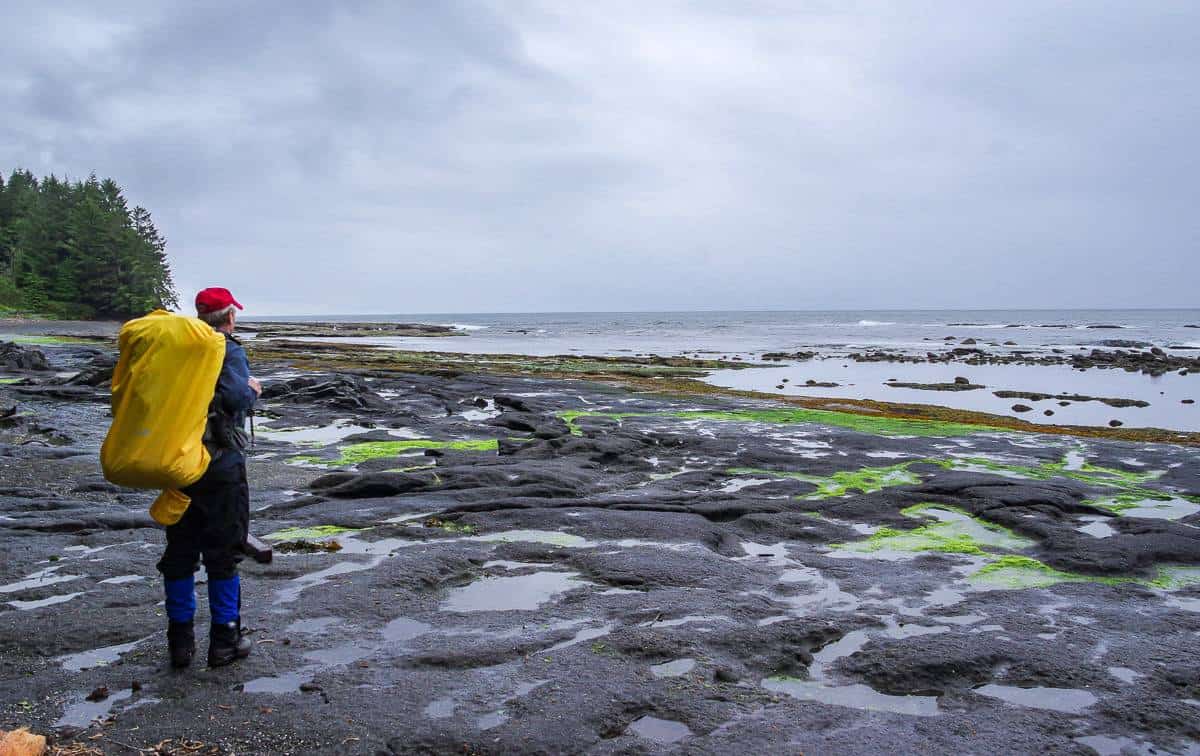
A great day trip from other towns on Vancouver Island
Botanical Beach is a fantastic day trip from as far away as Victoria. It’s 114 km from Victoria – though you’ll need to allow two hours one way as Highway 14 up the west coast of Vancouver Island is slow going.
The most expedient way to get to Botanical Beach is to drive. From May 1 – September 30th there is a shuttle bus for hikers on the Juan de Fuca Trail, so in theory you could take that – but only if you wanted to spend the entire day in Port Renfrew. You would be able to do a day hike on the Juan de Fuca Trail.
There is also a taxi from Sooke – so if you had a large enough group – or enough money that would be an option.
If you need to rent a car in Victoria you can do that through Discover Cars – and there is free cancellation.
The hike to Botanical Beach
Botanical Beach is the end point – or starting point – for the Juan de Fuca Trail, a 47 km cousin of the famous West Coast Trail, that lies just a little further north so you may see backpackers coming or going if it’s spring, summer, or fall.
There are two ways to get to Botanical Beach – the beach to beach trail for experienced hikers at low tide only!! or the 2.7 km loop trail which is well-signed and good for everyone.
The loop trail is the popular way to get to Botanical Beach. Over its length, enjoy spectacular ocean views, some muddy sections if its rained recently, beautiful sections of rainforest walking, Botany Beach, and then Botanical Beach. If you’ve timed your arrival with low tide, head first to Botanical Beach and visit Botany Beach on the way back.
The Beach to Beach trail should only be attempted at low tide. Check the Tide Chart.
From the beach at Botany Bay you can hike south to Botanical Beach BUT you have to deal with rocks and a bit of rock scrambling and you need to watch for rogue waves. It is best done by experienced hikers .
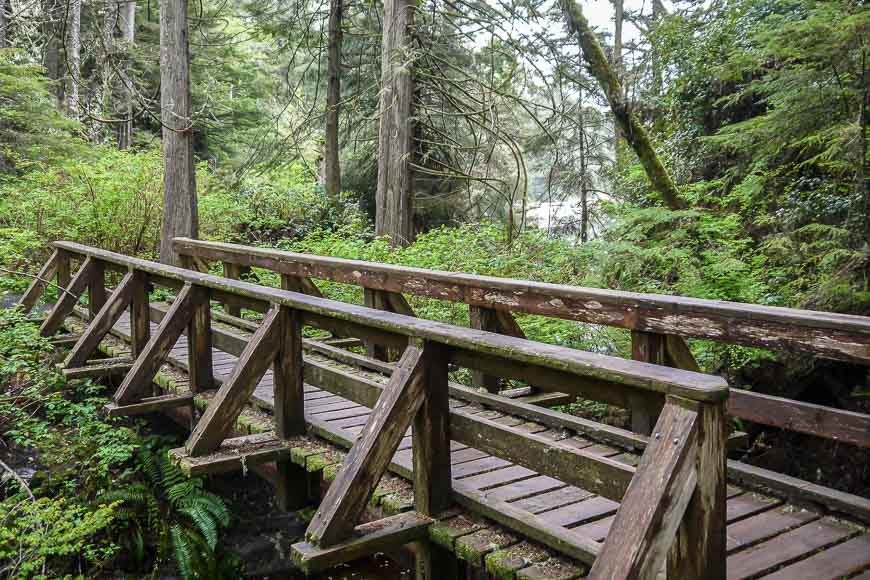
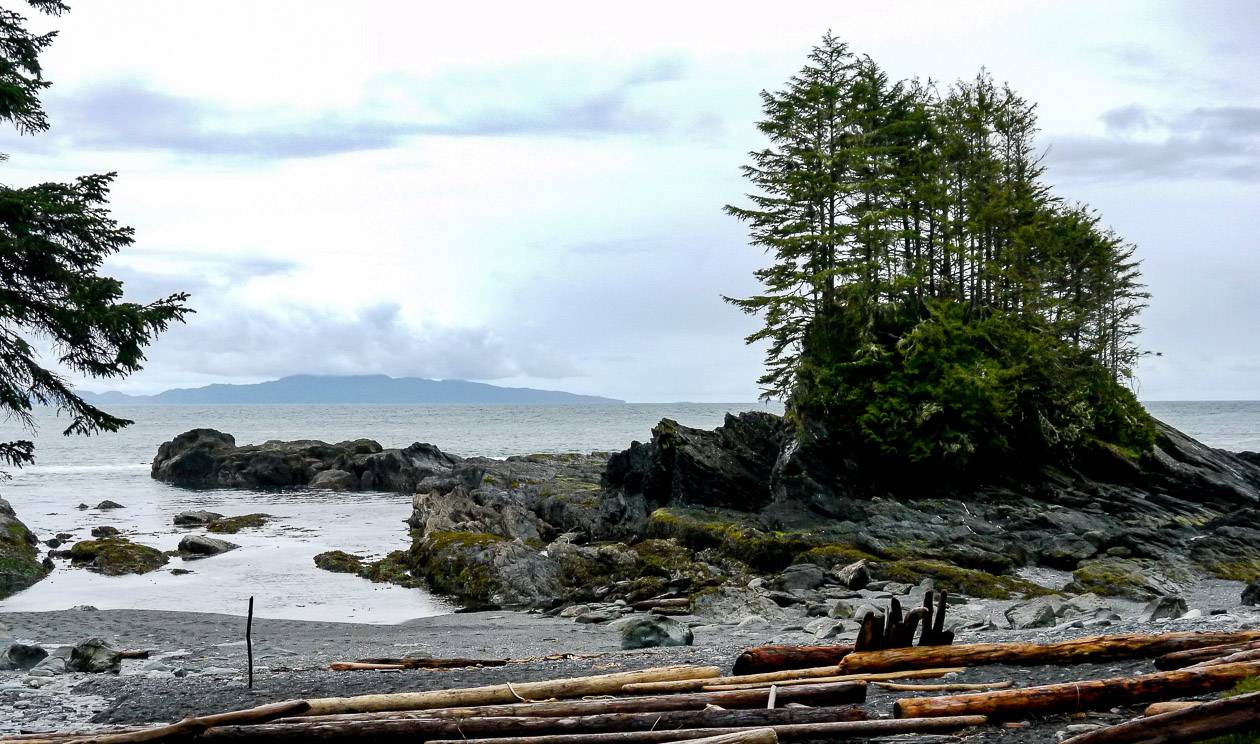
Visit Botanical Beach on a falling tide
The tide pools at Botanical Beach must be explored at very low tide – ideally on a falling tide – and all because you need to get out on the reef shelf to see the pools. Check out the tide charts for the day you want to go beforehand.
The tide pools contain all sorts of animal life – multi-coloured sea urchins, starfish, blue mussels, sea cucumbers, purple stone crabs, shore crabs and hermit crabs, octopus if you’re lucky, black katy chitons, limpets, sculpins, white goose-neck barnacles, periwinkles, coralline algae, and green sea anemones. See one of the photos below as a guide.
I’d recommend picking up a copy of the British Columbia Seashore Life folding pocket guide. Knowing what you’re looking at makes the visit to Botanical Beach that much more interesting.
You can spend many hours exploring the tide pools and enjoying a picnic – perhaps on the sandy beach at Botany Bay. Always be careful of where you stand. Avoid crushing any wildlife, falling into the pools or getting swept away by a rogue wave.

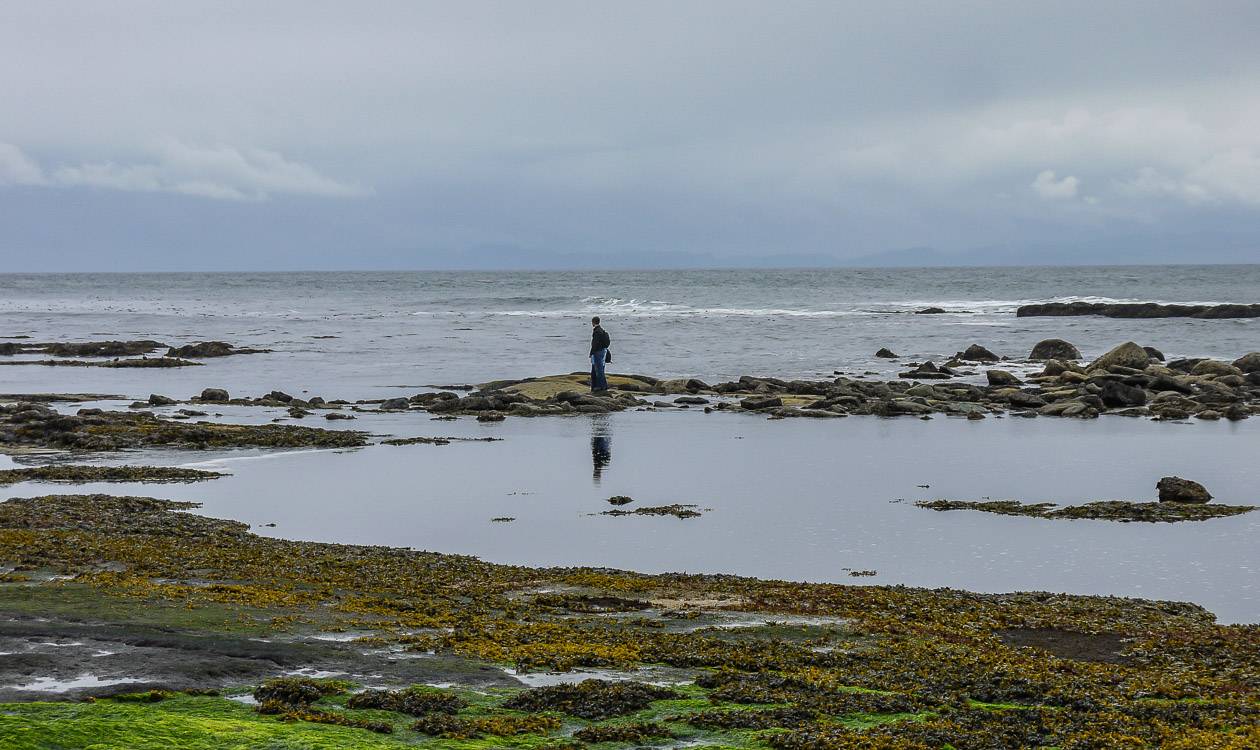
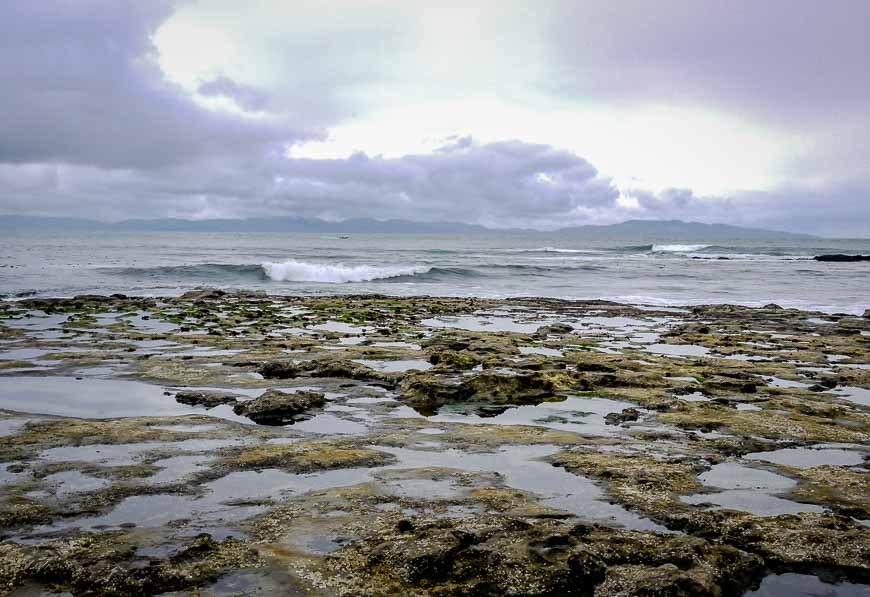
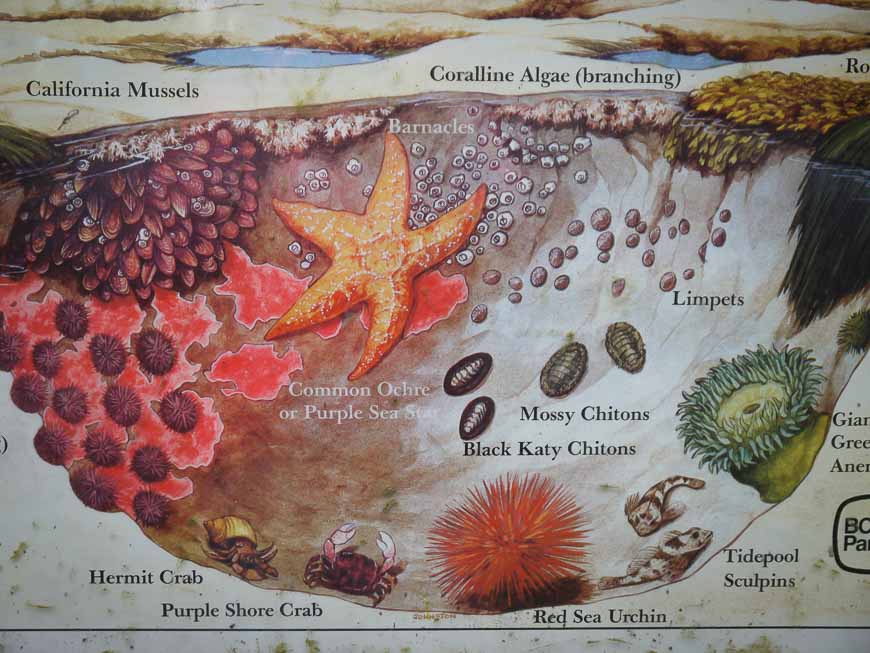
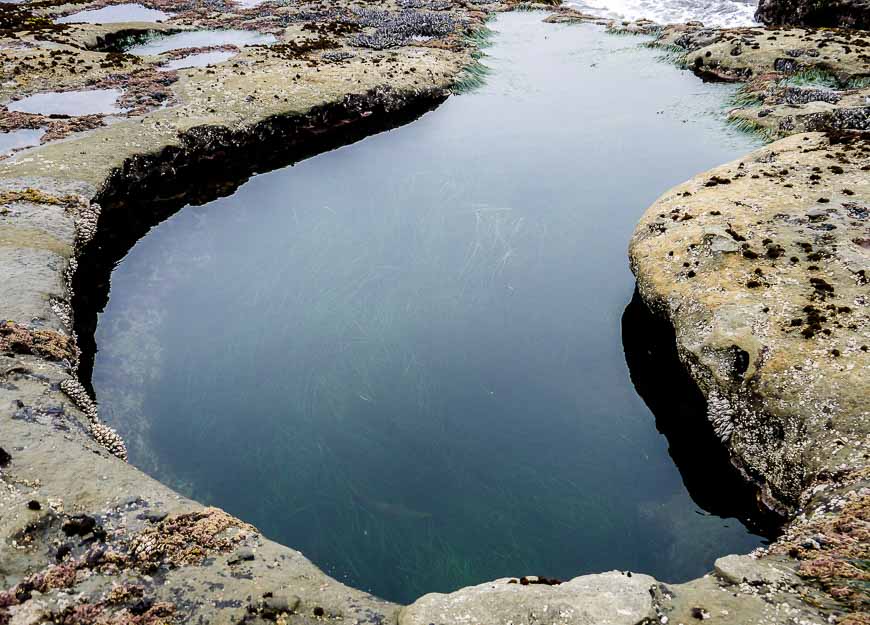
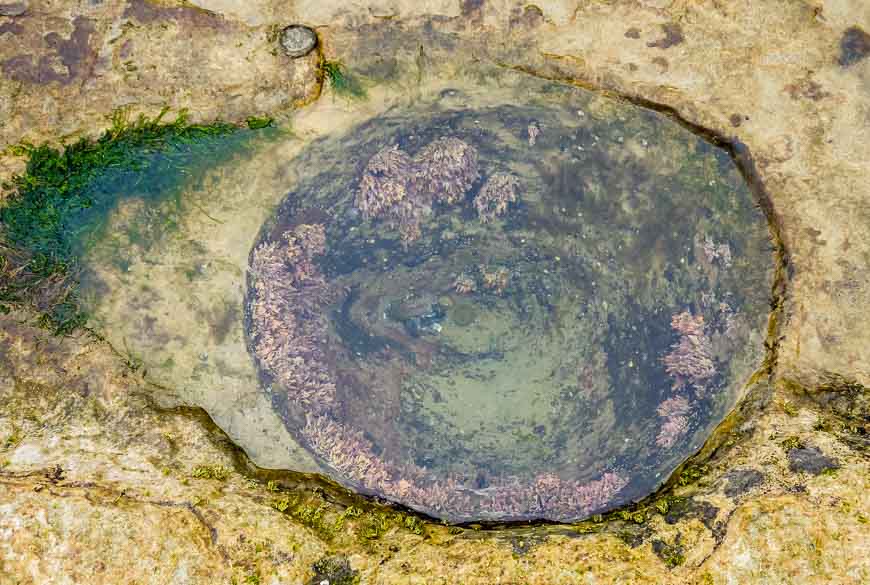
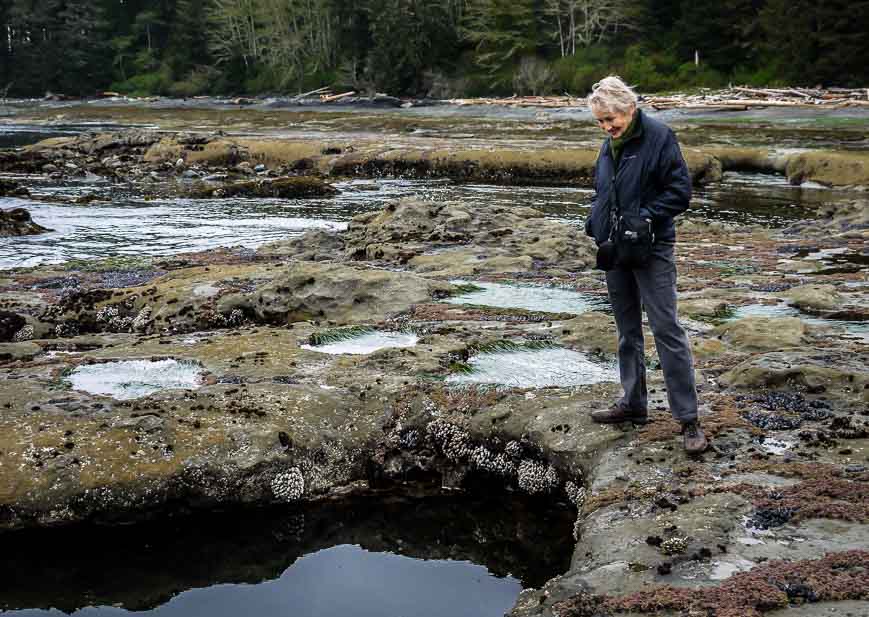
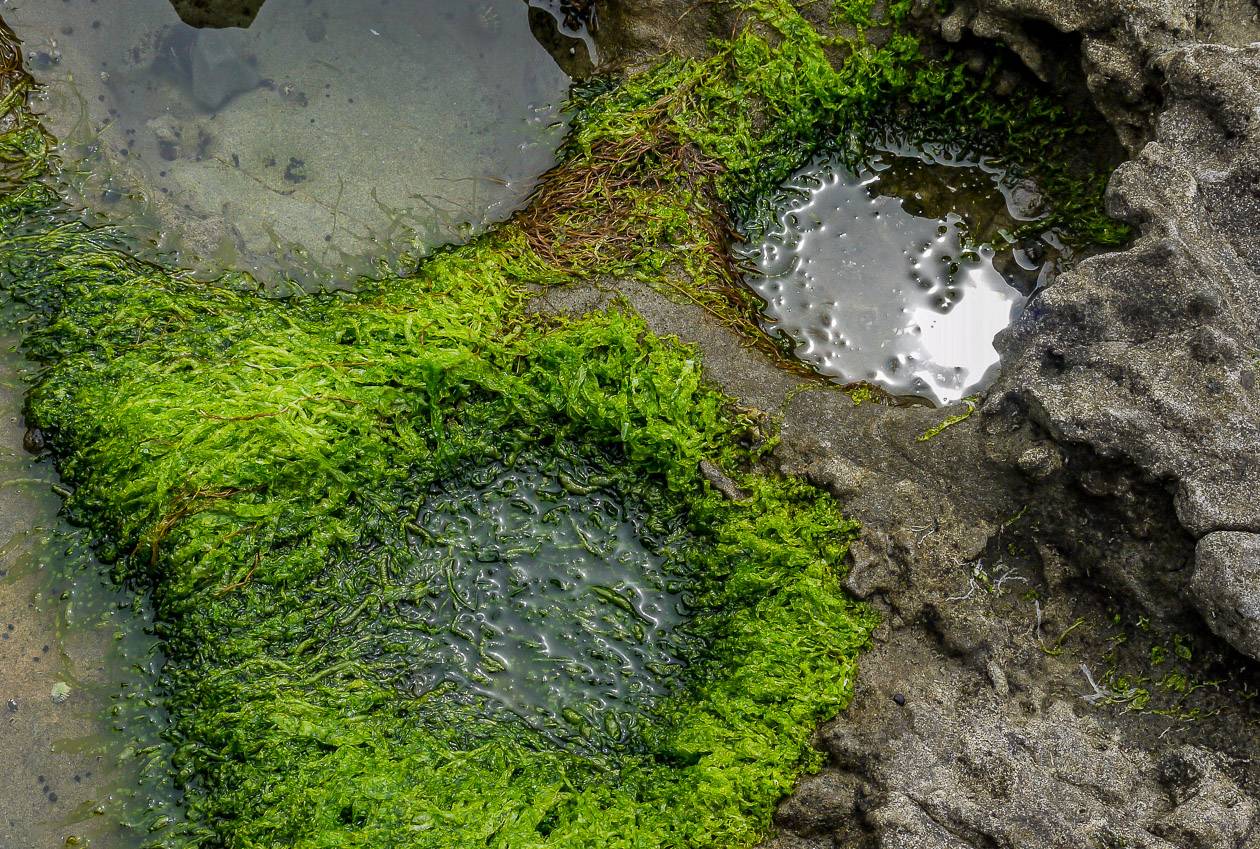
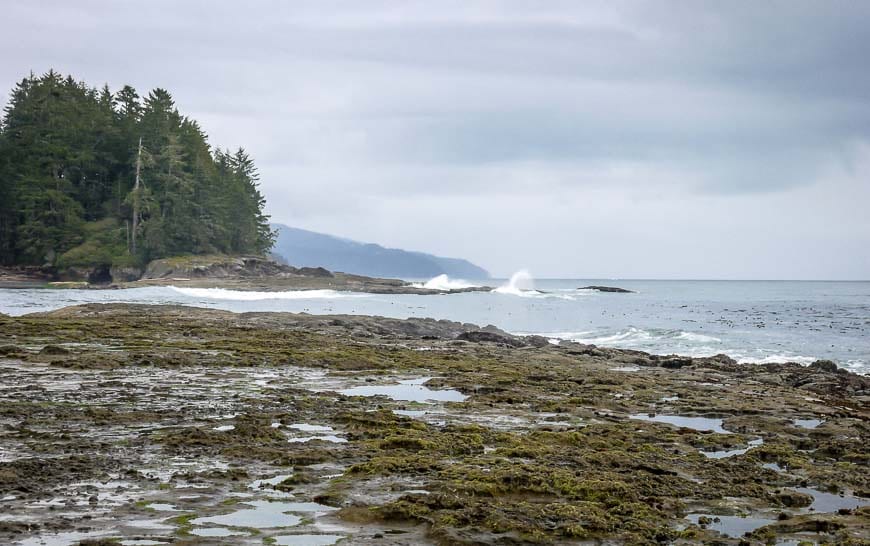

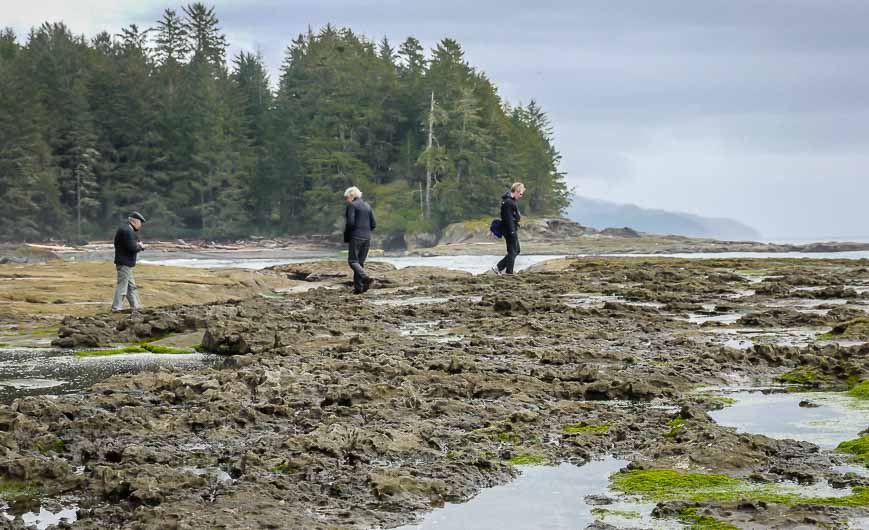
Other animals to look for at the beach
There are other animals you might see at Botanical Beach including killer whales and gray whales – which we saw blowing just off shore in April. March and April are typically the best time to see the gray whales as they migrate from the Mexican coast to Alaska.
From late August through March, keep an eye out for California and Stellar sea lions as they follow the fish. Look for harbour seals too.
This is black bear country, so even on the walk to Botanical Beach you could in theory run into a bear. Be sure to carry bear spray. We did see a lone black bear on the drive to the beach but not in the woods.
Cougars sightings are not uncommon too.
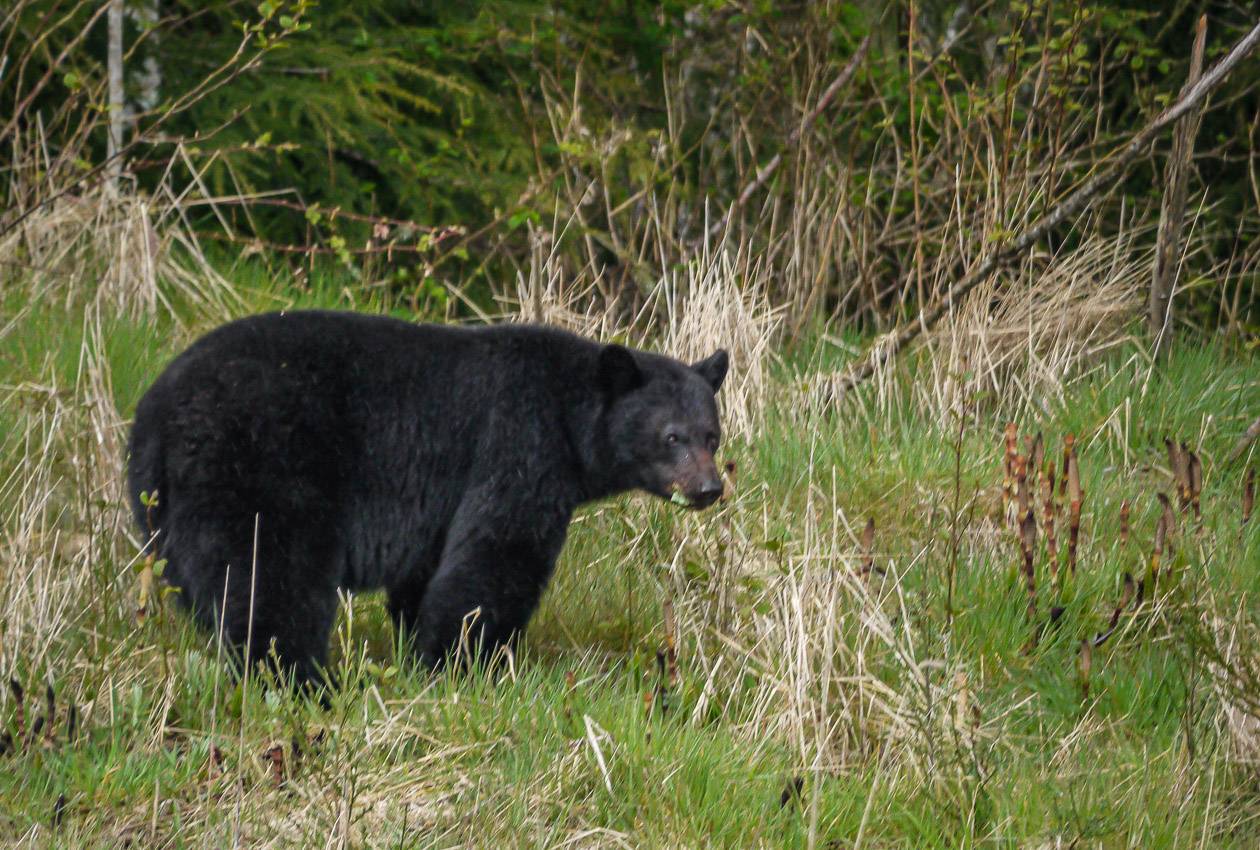
Where to stay near Port Renfrew
There is lots of variety including cottage type properties for rent in Port Renfrew. Check out the cabins at Wild Coast Wilderness Retreat. The West Coast Trail Lodge offers comfortable accommodation and is given very good reviews. Wild Renfrew Seaside Cottages – rated wonderful – will give you a lot of room to spread out.
Another great place to stay in Port Renfrew is the Soule Creek Lodge – with the option to stay in a beautiful yurt.
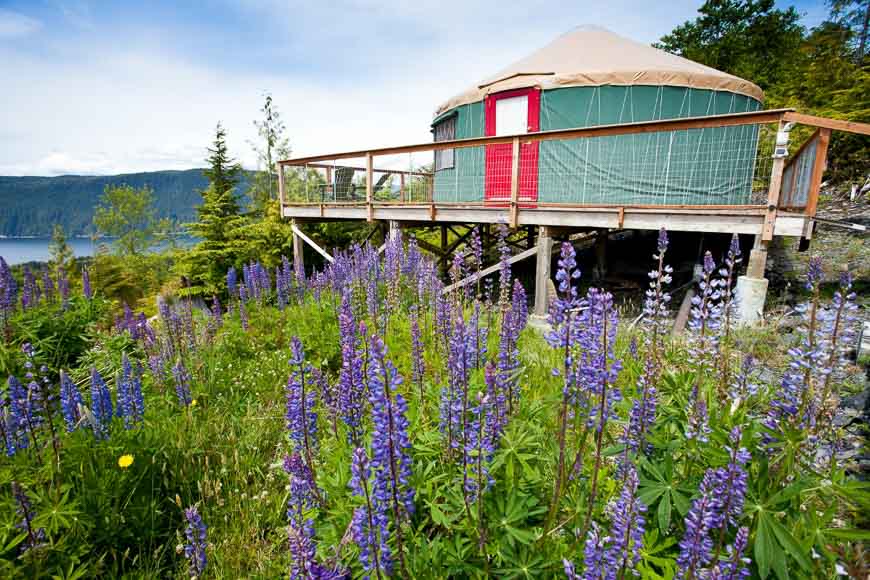
Further reading on things to do on Vancouver Island
- 7 Great Things You’ll Want to do in the Sooke Area
- Hiking in Victoria BC – A Couple of the Must Do Trails
- Nanaimo to Tofino Drive – 13 Fantastic Stops to Make
- A Stellar Visit to Long Beach Lodge Tofino, BC
- Victoria to the Cowichan Valley: A 6-Day Biking Itinerary
Click on the photo to bookmark to your Pinterest board.


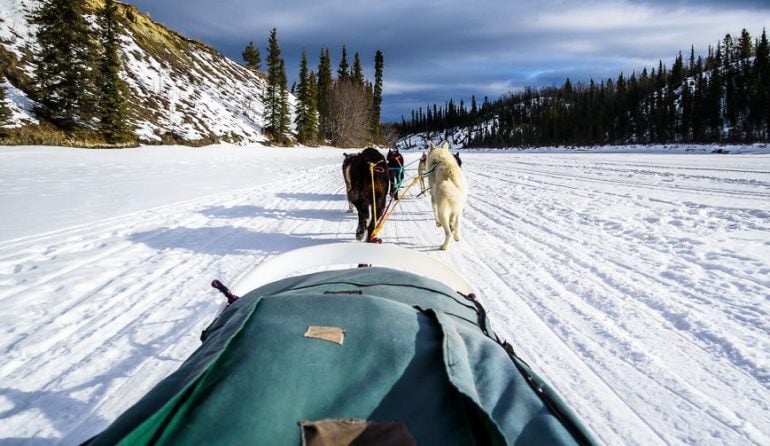
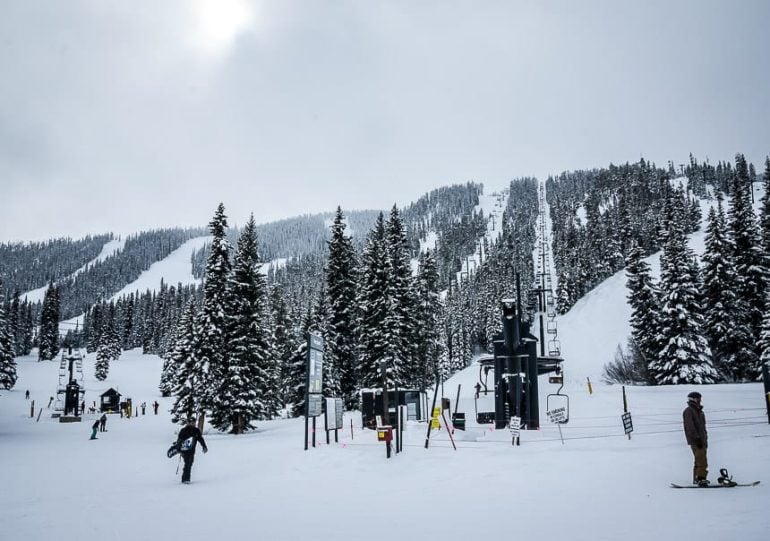
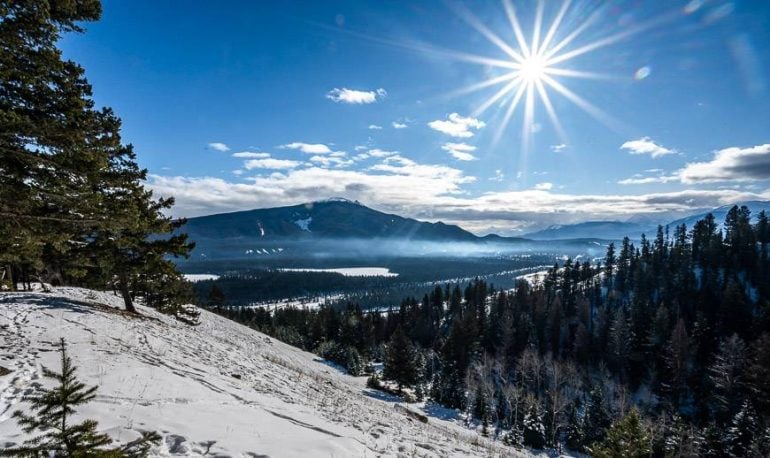
Whales and bears on the same trip? Now that is amazing.
@Scott Not too many places in the world where that’s possible. We were very lucky that day.
@Charu Bears were seen from the safety of our car so no worries – as long as you don’t come between momma & her cubs. I
I have to add this to my bucket list when I schedule a visit to Seattle and Vancouver–but agree with one of the comments above– that black bear!
The Juan Fuca trail is on my list of trails I want to hike, but haven’t made it there yet. The tide pools look really interesting. I could spend hours exploring them. Great photos!
I still haven’t hiked the whole thing either. I hear that Sombrio Beach is the best beach of all to camp at.
I recall, many years ago, enjoying tidal pools on Long Beach. It was absolutely fascinating. I have not heard of Botanical Beach before but when I have a chance to get out that way, I will check it out. Great photos. Thanks for sharing.
I had seen similar pools when I hiked the West Coast Trail – but I wasn’t in the lingering mood at the time. A trip to Botanical Beach if you’re in the area is definitely worth the effort.
I’m gonna love Vancouver, I just know it. 🙂
I think anyone who’s grown up on a coast – like you,or the water has a natural affinity for other cities with similar physical characteristics. That’s just part of the equation but I think you’ll have a blast Candice in Vancouver. Hope you have time to explore outside of the city too.
Leigh, thanks for the virtual return to Botanical Beach! Tidepooling here was one of my favorite activities on Vancouver Island, too — saw a blue starfish, plain as day (though, sadly, no whales).
I didn’t get a chance to hike the Juan de Fuca Trail, either, but I’d love to do it in the next few years, then head to Tofino and the Wickanninish Inn, then make it all the way to Telegraph Cove, the northernmost point of the island. Bet I could convince you to join me, huh? 🙂
Bet I would join you. I love kayaking out of Telegraph Cove but I might choose Middle Beach Lodge or Long Point Resort instead of the Wickanninish. I especially love the Great Room at Middle Beach.
Thanks for sharing all those pictures! Vancouver Island has so much to offer, I can’t wait to visit and hike one of the trails. Although that black bear has me a little worried…
Hiking the Juan de Fuca trail definitely has some appeal – especially early in the season when you most likely have the trail to yourself. Just FYI – I have heard that Sombrio Beach is the best of them all for camping overnight.